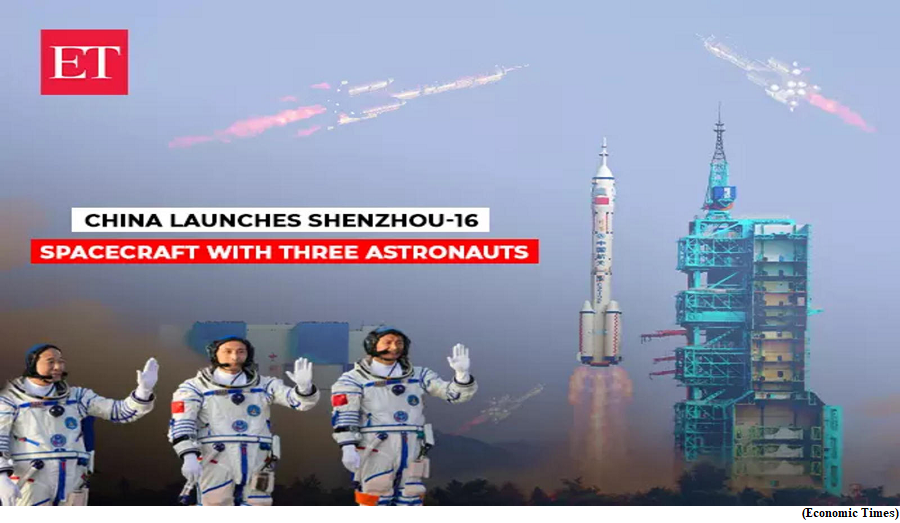China Shenzhou16 spacecraft launched (GS Paper 3, Science and Technology)

Why in news?
- Recently, China launched a spacecraft carrying three astronauts, including its first civilian, to its Tiangong space station.
Details:
- This is the China’s fifth manned mission to a fully functional space station since 2021.
- The Shenzhou-16, was launched atop a Long March-2F rocket from the Jiuquan Satellite Launch Centre in the Gobi Desert in northwest China.
- The crew of Shenzhou-16 includes Jing Haipeng as the leading commander on the mission, as well as Zhu Yangzhu and Gui Haichao, the first Chinese civilian to travel to space. So far, the Asian country has also been sending astronauts chosen from its People’s Liberation Army (PLA).
What is the new mission about?
- The three astronauts will replace the crew of Shenzhou-15 aboard the Tiangong space station, who have been there since November 2022.
- The new crew will stay there for the next five months and will carry out “large-scale in-orbit tests and experiments in various fields as planned.
- They are expected to make high-level scientific achievements in the study of novel quantum phenomena, high-precision space time-frequency systems, the verification of general relativity, and the origin of life.
What is the Tiangong space station?
- Operated by China Manned Space Agency (CMSA), the Tiangong space station was built by China after the USA barred NASA from working with the Asian country, citing a high risk of espionage
- The permanently inhabited space station’s first module entered orbit in 2021 and two more modules were added to it in the following years.
Way Forward:
- The Tiangong space station, expected to become the sole in-orbit outpost for scientific research after the end of operations for the International Space Station in 2030, is China’s ambitious project to achieve its space dreams.
- The country has already announced its plan to expand it, “with the next module slated to dock with the current T-shaped space station to create a cross-shaped structure”.
- China has also invited other countries and companies to collaborate and carry out experiments at its space station.
Fresh excavation reveals pre Mauryan era signs in Delhi’s Purana Qila site
(GS Paper 1, Culture)
Why in news?
- A fresh round of excavations at the site of Delhi’s Purana Qila (Old Fort) have uncovered evidence of the continuous history of the city since the pre-Mauryan era.
- The findings include shards of Painted Gray Ware pottery which are usually dated to around 1200 BC to 600 BC.
- The site could host one of the accompanying events during the G-20 leadership summit in September.

New excavations:
- The new excavations have also found remains of
- a 900-year-old Vaikuntha Vishnu from the Rajput period,
- a terracotta plaque of Goddess Gaja Lakshmi from the Gupta period,
- the structural remains of a 2,500-year-old terracotta ring well from the Mauryan period, and
- a well-defined four-room complex from the Sunga-Kushan period dating back to 2,300 years ago, besides beads, seals, copper coins and a bone needle.
Third round of excavation:
- More than 136 coins and 35 seals have been discovered from a small excavated area, indicating the site’s pivotal role as a centre for trade activities. This was the third round of excavations at the site, beginning from January.
- Earlier excavations had been carried out in 2013-14 and 2017-18.
- These efforts have revealed nine cultural levels, representing different historical periods, including pre-Mauryan, Mauryan, Sunga, Kushana, Gupta, post-Gupta, Rajput, Sultanate, and Mughal.
Background:
- The Purana Qila, built by Sher Shah Suri and Mughal emperor Humayun, is believed by many to be the site of Indraprastha, as mentioned in the Mahabharat.



